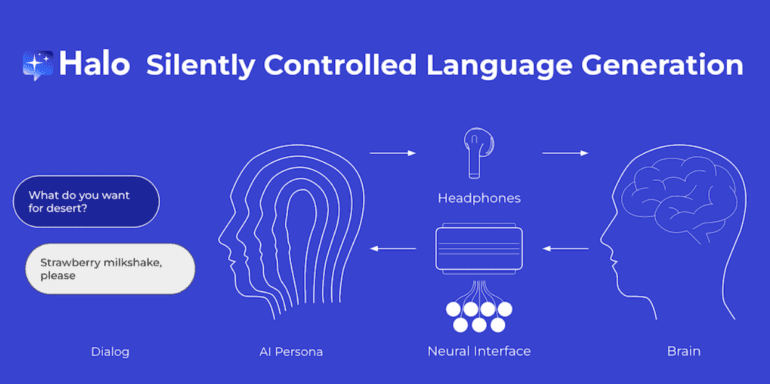TL;DR:
- Unbabel introduces a groundbreaking brain-to-computer interface project.
- EMG technology combined with AI enables thought-based communication.
- Halo app facilitates interaction with personalized Language Model (LLM).
- Current speed of 20 words per minute, aiming for 80 for consumer-grade usage.
- Potential applications include medical fields like ALS and Cerebral Palsy.
Main AI News:
Nestled within the confines of a vibrant Lisbon startup office, a scene unfolded that seemed to defy the boundaries of reality. Seated across from me was Vasco Pedro, the visionary founder and CEO of Unbabel, a trailblazing enterprise language translation services company. With an air of anticipation, I posed a question silently through my thoughts—a question only he could answer. What variety of coffee had I requested upon my arrival earlier today? In a matter of mere seconds, the response materialized on my screen, not as spoken words but as a text message: “You had an Americano.”
This Friday afternoon in Lisbon was an unexpected voyage into the future of human communication. I found myself in the midst of an unveiling, a preview of Unbabel’s revolutionary brain-to-computer interface project—a venture that bore the promise of endowing us with extraordinary cognitive abilities.
Embarking on this ambitious journey was the culmination of four years of relentless innovation. Unbabel’s primary objective—to bridge language barriers for global enterprises—propelled them beyond convention. As a startup that has secured an impressive $90 million in venture capital funding, sustained an annual revenue of approximately $50 million, and navigated the tumultuous pandemic landscape, Unbabel stands poised to explore the realms of what was once deemed improbable.
The Genesis of a Breakthrough
The inception of Unbabel’s brain-to-communication endeavor traces back to a spark of inspiration four years ago. Vasco Pedro elaborates, “We began to ponder the potential of brain-to-communication interfaces. It was a 20% project—an experiment of sorts.” Led by Paulo Dimas, Vice President of Product Innovation, Unbabel’s team embarked on a profound exploration of the evolution of human cognition.
Dimas elucidates this evolutionary journey, “The limbic system and the neocortex are distinct entities, the product of millions of years of evolution. We envisage the birth of an ‘uber cortex,’ an AI-powered entity existing beyond the confines of the biological brain.” Pedro elaborates that their inquiry ventured into the realm of electroencephalogram (EEG) systems, but the noise levels rendered EEG less than ideal. Elon Musk’s Neuralink, though groundbreaking, delved into invasive brain-computer interfaces.
Unlocking Potential with EMG
In a pivotal juncture, Unbabel’s vision found its anchor in electromyography (EMG), a technology used to gauge muscle response and electrical activity triggered by nerve stimulation. This technology, readily available and non-invasive, paved the way for a novel direction. Pedro explains, “Our realization was that EEG was plagued with noise. We sought a non-invasive route, and EMG, measuring muscle response, emerged as the quieter alternative. It enabled a more precise signal capture.“
The team’s breakthrough lay in the fusion of EMG with generative AI, specifically a personalized Language Model (LLM). The mechanism was ingeniously simple: the system tracked the wearer’s EMG response when contemplating a word, thus building a signal lexicon linked to actual words. By inputting these signals into a personalized LLM, a “bespoke LLM” came to life.
The Seamless Symphony of Thought
In an astonishing demonstration, Vasco Pedro showcased the system’s prowess. When queried about the coffee variety, he received the words via AI voice through his earbuds. As he contemplated words like “Black coffee,” the LLM gauged his physical response, cross-referenced “Americano,” and seamlessly relayed the response via text message. A mesmerizing dialogue, with no need for gestures or keystrokes, unfolded before my eyes.
Pedro expounds, “The LLM amplifies one’s expression. I craft the response through an interaction with the LLM, affirming the final message before it’s dispatched.” This exchange, occurring within the confines of one’s mind, mirrors a dialogue—a conversation that bridges the gap between intention and articulation.
The Path Forward
Unbabel’s innovation, aptly named “Halo,” encapsulates the promise of this transformative project. An accompanying app serves as the conduit for communication with the LLM and enables the user to access a central hub for interactions. The fusion of OpenAI’s ChatGPT 3.5 with the EMG-powered Halo underscores the synergy of generative AI and wearable technology.
Pedro draws parallels with the growth of driverless cars and the imminent data deluge. “We’re amassing vast amounts of data—the driving force behind our progress. With four years of groundwork, we stand at the precipice of accelerated advancement in generative AI.”
An Evolution of Communication
The convergence of generative AI and wearable devices heralds a new era. Just this week, neuroscientists harnessed AI to decipher the brain’s electrical activity and recreate music. This concept, gestating since the 1980s, now stands poised to reshape our interaction paradigms.
As Pedro concludes, “Halo’s current iteration, while nascent, attains an equivalent communication pace of 20 words per minute. To contextualize, Stephen Hawking communicated at two words per minute. Our aspiration is 80 words per minute—a level akin to consumer-grade communication. This journey paves the way to superhuman capabilities, where thought transforms into articulation.”
Conclusion:
Unbabel’s innovative Halo project unveils a new chapter in human-AI interaction. By seamlessly connecting EMG technology and generative AI, the mind-powered communication interface transcends traditional boundaries. This heralds transformative possibilities not only for global communication but also for medical applications, reshaping the landscape of AI-driven technologies. The market can expect an influx of advancements that leverage the synergy between human cognition and technological innovation.

